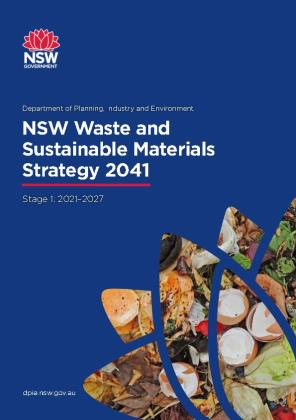Waste and Sustainable Materials Strategy
The strategy outlines the actions we will take to deliver on our long-term objectives to transition to a circular economy.
New South Wales is transitioning to a circular economy over the next 20 years. This means we will minimise what we throw away and use and reuse our resources efficiently, making them as productive as possible. We will end up with less waste, less emissions, less harm to our environment and more jobs. The move will boost innovation and help drive our economy.
We need to have the services and infrastructure in place to deal with our waste safely, to ensure it does not become a problem for future generations. We also need to work with consumers, industries and other governments to make the circular economy a reality.
The NSW Waste and Sustainable Materials Strategy (PDF 2.1MB) outlines the actions we will take over the next six years, the first phase of the strategy, to deliver on our long-term objectives.
These actions are backed by $356 million in funding to help deliver priority programs and policy reforms.
Some of our key reforms include:
- phasing out problematic single-use plastic items
- financial incentives for manufacturers and producers to design out problematic plastics
- having government agencies prefer recycled content
- mandating the separation of food and garden organics for households and selected businesses
- incentivising biogas generation from waste materials
Our targets are:
- reduce total waste generated by 10% per person by 2030
- have an 80% average recovery rate from all waste streams by 2030
- significantly increase the use of recycled content by governments and industry
- phase out problematic and unnecessary plastics by 2025
- halve the amount of organic waste sent to landfill by 2030
- reduce litter by 60% by 2030 and plastics litter by 30% by 2025
- triple the plastics recycling rate by 2030
The EPA Waste Delivery Plan (PDF 4.8MB) provides more detailed information on each initiative within the Strategy and the NSW Plastics Action Plan.
Meeting our future infrastructure and service needs
As waste volumes grow, infrastructure and services need to keep pace. We need to ensure we have the capacity to meet our critical future needs, such as residual waste capacity, as well as stimulating investment in a pipeline of innovation.
Reducing carbon emissions through better waste and materials management
Transitioning to a circular economy means increasing our resource efficiency and reducing our carbon footprint. If we can make our materials more productive by improving their durability through design, reusing or repairing them, recycling and remanufacturing them or extracting their embodied energy, we can reduce our reliance on emissions-intensive virgin materials.
Building on our work to protect the environment and human health from waste pollution
Waste can cause enormous damage to our natural environment and threaten the health and well-being of our community if it is not properly managed. Littering, illegal dumping and mishandling of hazardous wastes costs NSW millions of dollars each year. We need to maintain strong regulations to help stop this waste pollution, and engage with businesses and consumers to drive positive behaviour change.
New opportunities under the strategy
The NSW Government will invest $356 million over 5 years, with funding commencing from July 2022. The government is providing a further $85 million over the 2021–22 financial year to continue key waste and resource recovery activities and support councils to deliver waste services, tackle illegal dumping and develop regional waste strategies.
New funding commitments under the strategy include:
- a $37 million Carbon Recycling and Abatement Fund to support innovative circular economy approaches that manage waste and materials more efficiently and reduce emissions
- a $16 million investment in a new joint procurement facilitation service to make it easier for local government to collectively procure waste services
- $24 million to catalyse investment in strategic waste and circular economy infrastructure
- $65 million to support the rollout of new organics collection services and a further $4 million for food donation infrastructure and equipment
- $13 million to support research into new technologies and uses for recycled material and to provide opportunities to pilot them in government projects through the new Circular Innovation Fund
- $15.6 million in funding for local government collaboration through regional organisations of councils, council groups, joint organisations and voluntary regional waste groups
- more than $10 million for local councils to continue litter reduction and illegal dumping prevention activities
- continued funding of $6 million for the Landfill Consolidation and Environmental Improvements Grants Program to support regional councils, and $7.5 million to support the installation of landfill gas capture infrastructure
- $66 million for continued support of community recycling centres and household chemical clean out events
- $16 million to continue work in combating illegal dumping and $5 million for continuation of the NSW Asbestos Coordination Committee
- $5 million in ongoing support for the planning and delivery of waste management projects working in partnership with Aboriginal communities across NSW
- $15 million to continue the Bin Trim program, which assists small and medium businesses to reduce and recycle waste
- $38 million for litter prevention programs to protect our environment and waterways.



